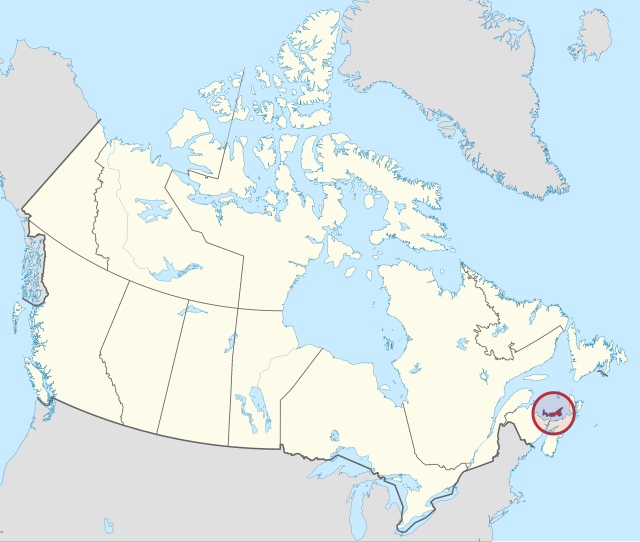پرنس ايڊورڊ ٻيٽ
From Wikipedia, the free encyclopedia
From Wikipedia, the free encyclopedia
پرنس ايڊورڊ ٻيٽ (انگريزي ٻولي: Prince Edward Island) ڪينيڊا جو ھڪ صوبو آهي. هي ننڍڙو ٻيٽ ائٽلانٽڪ سمنڊ ۾ نيو برنزوڪ صوبي جي سامونڊي ڪناري تي واقع آهي، جتي اهو خاص طور تي اتر آمريڪا جي اڀرندي ساحل تي واقع آهي.[5] اهو علائقي ۾ ڪينيڊا جو سڀ کان ننڍڙو صوبو آهي آبادي جي لحاظ کان پرنس ايڊورڊ ٻيٽ پنهنجي خوبصورت قدرتي نظارن جي ڪري مشهور آهي ۽ ان جي گهٽ قيمت آهي، اتي ڪيتريون ئي ثقافتون آهن ۽ اهو روايتي ۽ جديد ثقافت جو هڪ منفرد ميلاپ آهي.[6]
| Prince Edward Island Île-du-Prince-Édouard (فرانسيسي)[1] | |||
|---|---|---|---|
| Province | |||
| |||
| نعرو: Parva sub ingenti (Latin) "The small protected by the great" | |||
 | |||
| جاگرافي بيهڪ: 46°24′N 63°12′W[2] | |||
| حڪومت | |||
| • قسم | Parliamentary constitutional monarchy | ||
| پکيڙ[4] | |||
| • ڪل | 5,660 ڪ.م2 (2,190 ميل2) | ||
| • زميني | 5,660 ڪ.م2 (2,190 ميل2) | ||
| • آبي | 0 ڪ.م2 (0 ميل2) | ||
| پکيڙ ۾ درجو | 13th | ||
| آبادي (2021) | |||
| • ڪل | 154,331 | ||
| • ڪاٿو
Q2 2024 |
177,081 | ||
Prince Edward Island (PEI; فرينچ: Île-du-Prince-Édouard; سانچو:Lang-gd; colloquially known as the Island) is one of the thirteen provinces and territories of Canada. While it is the smallest province in terms of land area and population, it is the most densely populated. The island has several nicknames: "Garden of the Gulf", "Birthplace of Confederation" and "Cradle of Confederation".[7] Its capital and largest city is Charlottetown. It is one of the three Maritime provinces and one of the four Atlantic provinces.
Part of the traditional lands of the Miꞌkmaq, it was colonized by the French in 1604 as part of the colony of Acadia. The island, known as Isle St-Jean (St-John's Island), was ceded to the British at the conclusion of the Seven Years' War in 1763 and became part of the colony of Nova Scotia. In 1769, St. John's island became its own British colony and its name was changed to Prince Edward Island (PEI) in 1798. PEI hosted the Charlottetown Conference in 1864 to discuss a union of the Maritime provinces; however, the conference became the first in a series of meetings which led to Canadian Confederation on 1 July 1867. Prince Edward Island initially balked at Confederation but, facing bankruptcy from the Land Question and construction of a railroad, joined as Canada's seventh province on 1 July 1873.
According to Statistics Canada, the province of Prince Edward Island had 176,113 residents in 2023.[8] The backbone of the island economy is farming; it produces 25% of Canada's potatoes. Other important industries include fisheries, tourism, aerospace, biotechnology, information technology and renewable energy.[9] As Prince Edward Island is one of Canada's older settled areas, its population still reflects the origins of its earliest settlers, with Acadian, Scottish, Irish, and English surnames being dominant.
Prince Edward Island is located in the Gulf of St. Lawrence, about 10 km (6 miles) across the Northumberland Strait from both Nova Scotia and New Brunswick. It is about 200 ڪلوميٽر (120 ميل) north of Halifax and 600 ڪلوميٽر (370 ميل) east of Quebec City. It has a land area of 5٬686.03 km2 (2٬195.39 sq mi),[10] is the 104th-largest island in the world and Canada's 23rd-largest island. It is the only Canadian province consisting solely of an island.
| پرنس ايڊورڊ ٻيٽ | |
|---|---|
| صوبو | |
| Prince Edward Island |
Seamless Wikipedia browsing. On steroids.
Every time you click a link to Wikipedia, Wiktionary or Wikiquote in your browser's search results, it will show the modern Wikiwand interface.
Wikiwand extension is a five stars, simple, with minimum permission required to keep your browsing private, safe and transparent.